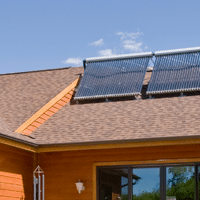Prefab homes have come far in the past 15 years. Colorado’s Solar Village Homes builds prefab homes that are functional, flexible, and long-lasting and filled with numerous green technologies. “We sit down with the client and custom-design the house to their needs,” says Alex Platt, a project architect at Solar Village. The owners of the Kettering Residence are musicians, so the architects included a guitar practice room and two spaces for piano practice and performance. Here, Platt and Solar Village founder Mark Kostovny discuss the finer details of the project.
Passive Design
The Kettering Residence, like many Solar Village homes, is designed around passive-solar principles. To heat the house on extremely cold days, Solar Village installed an evaporating-tube solar-hot-water system that creates domestic hot water and radiant floor heat, backed up by a condensing high-efficiency boiler. When combining passive solar design and radiant floor heat, Solar Village adds one and a half inches of lightweight concrete, or gypcrete, to protect the radiant tubing. “The gypcrete also works as a thermal mass that we can heat up with the passive radiation of the winter sun,” Platt says.
Efficient Insulation
The home uses Icynene water-based spray foam that fills the cavities of the walls, creating a high R-value and a near-airtight seal of the houses. The house also is wrapped in Poly ISO rigid foam, which according to Kostovny, minimizes thermal bridging. The rigid foam has a foil face as well that reduces radiant gain both internally and externally. In the summer, it keeps the sun from radiating through the walls, and in the winter, the heat stays inside.

On the home’s south-facing roof is an evaporated-tube solar-hot-water system for radiant floor heat that will complement its passive design. Photos: Luke Urbine
Recycled Wood
For exterior siding, Solar Village is keen on a Louisiana Pacific product called SmartSide. The siding has a 50-year warranty and is made of recycled wood. “The factory-applied paint or stain lasts twice as long as a field-applied paint or stain, which is important in Colorado where you have a strong radiant-solar exposure,” Kostovny says.
Adaptive Windows
Both Kostovny and Platt claim fiberglass window frames are far superior to others. Fiberglass expands and contracts at about the same rate as window glass. “On windows made with a wood frame, or vinyl or aluminum,” Platt says, “you can actually hear the cracking noise when the sun heats the window because it’s fighting that seal with the materials expanding at different rates.” This project features a product called Endurashield (made by Weathershield), a fiberglass frame with a wood interior. “They got the best of both worlds,” Kostovny says of the owners. “The beauty of wood on the inside and the performance of fiberglass outside with near-zero maintenance.”
Fresh Air
“We use low-VOC paints, glues, and wood products,” Platt says. “The cabinets in this house were IKEA cabinets. Europeans have a much higher standard for wood off-gassing.” To further ensure indoor air quality, Solar Village uses heat-recovery-ventilation systems that bring outside air in to temper the air before entering the space through a heat exchanger, which brings a constant turnover of air into the houses. “Most houses leak haphazardly,” Kostovny says. “This gives you a guaranteed way to continue to subtly flush the house with fresh air 24 hours per day.”

